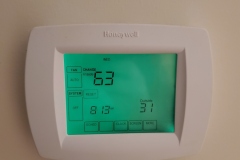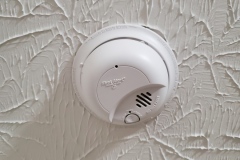It’s that time of year again when you should be checking the batteries in your smoke alarms, carbon monoxide alarms, and thermostat. Spring is the perfect time to check and change out the necessary batteries because it makes it easy to remember when you did it if you do this regularly.
Smoke Alarms
Batteries should be changed out every 6 months according to the National Fire Protection Association (NFPA). Most alarms only use batteries as a backup because they are hardwired, but that is not always the case. Some detectors have a built-in battery that may last up to 10 years before having to be disposed of.
Smoke alarms are an important item to keep up with as they may very well save your life in the event there is a fire. The Ohio Board of Building Standards says that a properly installed smoke alarm can alert you 24 hours a day 7 days a week. Plus, smoke alarms are constantly sampling the air for fire and smoke regardless of whether you are awake or asleep.
Smoke alarms should be tested regularly to ensure they are working properly and that the batteries haven’t died every month. First Alert recommends changing out the alarms at least every 10 years to ensure you have a properly working alarm in the event there is an emergency.
According to the NFPA, you should install a smoke alarm that detects both ionization and photoelectric technologies. This will provide homeowners with the earliest possible warning and the longest possible escape time, no matter what type of fire is encountered.
For the hearing impaired there are smoke alarms that have low frequency, strobe lights that flash, or vibration to help bring attention to the user that there is an issue. There may be newer technology on the market as this seems to keep evolving.
Check with your local building or fire department for a reduced price or even free, smoke alarms. When ready to replace do your research to see what smoke alarms are viewed the best on the market. Being prepared and having plans in place in case of a fire will increase your chances of escape as well as prevent further damage to your home if caught early.
Carbon Monoxide Alarms
It is very important to have a carbon monoxide alarm in your home due to the fact you cannot see or smell the gases. It is known as the “silent killer” because we are not aware of its surrounding, which is why it is very dangerous and deadly. Carbon monoxide is very dangerous to humans and pets’ health when inhaled. Having a CO alarm not only gives you peace of mind, but it protects you and the ones you love from experiencing carbon monoxide poisoning.
According to First Alert carbon monoxide alarms detect poisonous gases and provide early warnings in the event there is a CO leak. It is critical to point out if your CO alarm is going off that you get fresh air as soon as possible.
Things that produce carbon monoxide are any items that are a fuel-burning device such as gas fireplaces, kerosene heaters, gas furnaces, gas water heaters, and a gas dryer and ranges. It is important to point out that wood stoves even though not fueled by gas can produce CO in your home. Contact your local fire department if you are not sure what will cause CO in your home, they should be able to help.
Every level of a home must have a CO alarm so everyone can be alerted quickly to the emergency. It is best to have CO alarms in each room that has a family member sleeping in them. CO alarms can be placed anywhere in the room for any detection of poisonous gas as long as they are not obstructed.
Be responsible for knowing how your CO alarm works. Just because your CO alarm goes off does not mean there is CO in the area. Learn the different beeps of your particular CO alarm because they mean different things such as low battery or end of life of the alarm. Some CO alarms have a display screen that allows you to view the message of the alarm while others may be a series of beeps describing what the issue is for that particular device.
Just like your smoke alarms the CO alarms need to be checked as well once a month to ensure they are working properly and that the batteries are not dead. Make sure to keep the CO alarm clear of obstructions, clean, and dust-free at all times. It is important to note that the CO alarms need to be replaced between 5 – 7 years according to First Alert.
According to Fire Fighter Insider responding to check CO and other potentially dangerous gases is one of the many things fire departments are responsible for. They use meters called Combustible Gas Indicator (CGI’s) to help them check for various dangerous gases and their levels. They will assess the danger, find the potential sources of the gas and do whatever is necessary to make the space safe again for you and your loved ones.
Typically, your gas company does not check for CO. If you suspect CO in your home, you should call your local fire department, 911 for an emergency, or any professional on-site air testing company. If you call 911, they will dispatch the fire department and any other necessary emergency personnel to respond to your home and check for poisonous gases. You should never try to assess a gas leak yourself especially when you don’t have the proper meters and training to do so. Leave it to the professionals!
Thermostats
Batteries in thermostats are needed to help keep settings during a power outage as well as keeping the original settings. Batteries help act as a secondary power source. It helps keep your settings, preferences, and schedule in place without having to reset every setting. If the batteries were to die you would have to solely rely on your memory to reset all the settings on the thermostat.
Most thermostats allow you to program them to fit your needs. Whether you want it hot/cold when you wake up or set it to turn off when you leave for work and turn back on when you return. Some thermostats allow you to turn them on and off remotely as long as there is Wi-Fi.
Setting up your thermostat to your preferences can help cut costs since you can set times when the thermostat kicks the furnace on and off. This is more energy-efficient since your furnace isn’t running to heat or cool an unoccupied home.
Changing batteries regularly in your thermostat helps you maintain control of your HVAC. Also, it helps save time from having to manually turn it on and off, especially once the power comes back on. Without battery backup, your thermostat will not automatically come on or function properly without your assistance. Some thermostats are hardwired and only use battery backup when the power goes out. Most have a display showing the battery life along with an audible sound letting you know the battery needs replaced. They need to be replaced quickly to avoid performance issues and having to reset everything that you programmed.
It is recommended to change batteries out at least once a year. Thermostats with fresh batteries help keep everything running without a problem. It ensures the thermostat is running properly with no issues and saves you time from having to reprogram the settings.



I have been surfing online more than 3 hours today yet I never found any interesting article like yours It is pretty worth enough for me In my opinion if all web owners and bloggers made good content as you did the web will be much more useful than ever before